|
Silo tower - These are long vertical silo of steel or
concrete.
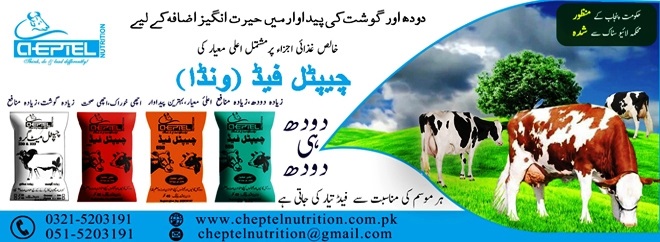



Silage Bunker - Silage Bunker is most commonly used type of
silo. This is rectangular structure which is open from one side or
both sides. On both sides of walls of wood, steel, concrete are
constructed. Dimensions of bunker depends upon the amount of fodder
to be stored.
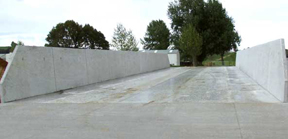

Temporary Bunker - Temporary bunker consists of two frames of
steel or iron which are covered by sheets of steel, iron or wood.
The function of these frame is same as that of the wall of bunker but
difference is that these are portable and can be easily transferred
from one place to other place. Wherever fodder is to be preserved,
these frames are fixed with the help of stands on both sides and
space is filled with fodder. After compaction of fodder these
frames are removed and can be used somewhere else. Hay bales can
also be used in place of frames for this purpose.
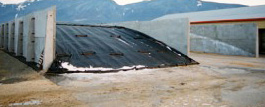
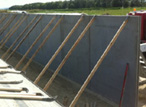

Silage Pit
- In this type of silo, a pit is constructed in ground. It
may be rectangular or cylindrical


Trench Silo - This is compromised form of silage pit and bunker
in which some fodder is preserved inside of pit and some outside of pit

Baled Silage
- This is the most modern way of silage making in which fodder
is preserved in the form of bale. Fodder is converted into bale via
machine called silage baler and this bale is then tightly wrapped
with polyethylene sheet with the help of wrapper. This bale can be
easily transported.
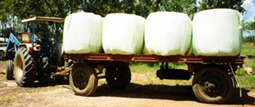


Site Selection for Silo:
-
Site should
be easily approachable from fields as well as dairy farm
-
The area
should not be low lying because such type of areas are prone to
water logging
-
The
chaffing shed should be adjacent to the site
-
It
should be away form residential area
-
Tractor should easily reach the site
-
It
should be 60 meters away from water pond etc.
-
Trees should not be around
Construction of Silage Bunker:
For construction of bunker, concrete floor is constructed which is
kept 1 feet high in middle giving slope on both sides. On both sides
of this floor, walls are constructed. For construction of wall 1.5
feet high base is constructed; width of first step of this base is
kept 36 inches, width of second step is kept 30 inches and width of
remaining step is kept 27 inches. On this base, construction of wall
is started. Width of the end of wall attached is kept 27
inches and after this width is started reducing until it reaches 13
inches. Height of wall should be 6-7 inches. The width of bunker
should be at least double than the width of tractor. From front and back
sides bunker should be open. Out of front and back side,
concrete floor is constructed upto 15 feet. Benefits to keep both sides open are:
-
Due
to slops on both sides, there is no danger of falling of tractor
-
Due
to lack of fear, driver is comfortable and compress fodder at
corners
-
Silage can be utilized from both sides
-
When
half of the bunker becomes empty, this space can be again filled
for silage making, while prepared silage can be utilized from
opposite side
-
Expenditures of construction are reduced
Regarding the dimensions of bunker one formula should be kept in
mind that one cubic fit space will be filled by 18-20 Kg fresh
fodder i.e. bunker having 1 feet length, 1 feet width and 1 feet
height will carry 18-20 feet fresh fodder. On this base we can say
that a bunker having 75 feet length, 25 feet width and 7 feet height
will carry 235-265 ton fresh fodder and silage prepared from this
will be sufficient for 40-50 animals for 6 months.

Steps in the Preparation of Good
Silage
To
get a good silage one should take care at every stage of ensiling.
Selection of Fodder:
There should be adequate amount of fermentable carbohydrates and
more than 65% moisture in fodder selected for silage making.
Commonly used fodder for silage making are maize,
sorghum, millet, oat, and sorghum sudan grass. Leguminous fodder
crops can also be used for silage making but they contain fewer
amounts of carbohydrates hence molasses or mineral have to be
sprinkled over them at the time of silage making. Most of the time
maize is used for silage making as maize silage is considered the
best silage throughout the world.


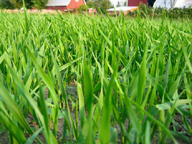
Maize
Millet
Oat
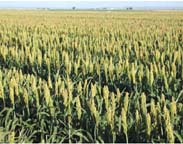
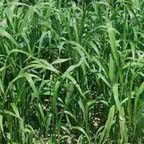
Sorghum
Sorghum Sudan Grass
Harvesting and Chopping of Fodder:
Crop should be harvested at the stage when there are maximum
nutrients present in crop and 65-70% moisture content. In case
of maize moisture reaches this
level when:
-
Color of Lower leaves of plant starts changing to light green
-
Husk's color is from green to light green
-
Kernel has visible dent
-
There is 40-50% moisture in grain
-
Kernel Milk line is 50%
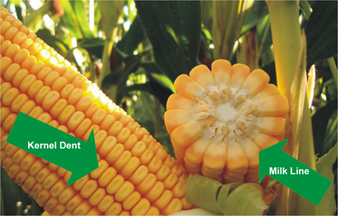
Grab
test is used to measure the moisture concentration in fodder. To
check the moisture, take a hand full of fodder and press it in hand
for few seconds. On opening of hand, there will be a ball of fodder:
-
If
this ball suddenly opens, it means moisture connect is too low
-
If
this ball remains it shape, it means moisture content is too
high
-
If
this ball opens slowly, it means moisture content in fodder is
suitable to be ensiled
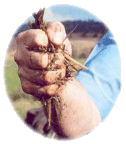 e e
Another
test to check the moisture content in fodder is oven test. This test
consists of following steps:
-
Take fresh fodder
(not more than 50 grams)
-
Note down the weight
of this fodder
-
Place it in oven for
few seconds and again weigh it
-
Again place in oven
and weigh it. Repeat this step again and again until no change
occurs in weight of fodder. No change in weight shows that
moisture is no more in fodder and only dry matter is left
-
Now note down the
weight of this dried fodder
-
Find moisture
content in fodder with the help of this formula
|
% Moisture = |
Weight of fresh fodder - Weight
of dry fodder |
× 100 |
|
Weight of fresh fodder |
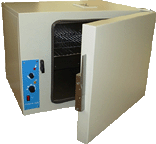
Moisture
content in fodder can also be checked by electronic moisture tester

Use maize chopper for harvesting and chopping of fodder. If maize
chopper is not available then harvest it and chop it upto size of
1-2 cm.
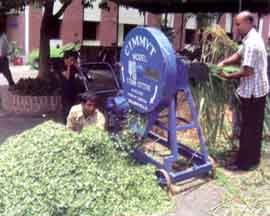

Filling of Silo:
After chopping and adding additives silo is filled. Inside silo
chopped fodder should be compressed with tractor or some other means
so that it is packed tightly and there is no air left. If air left
anaerobic condition will not be created. In case of baled silage,
silage baler makes bale in well compacted form.
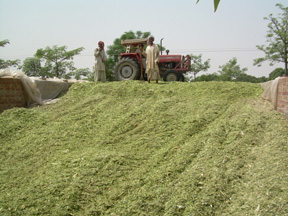
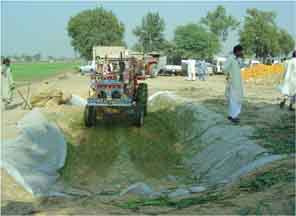
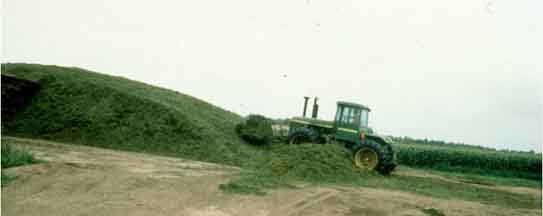

Mixing of Additives:
Different feed additives may be mixed to stimulate or inhibit the
microbial activities in silage. These additives may include:
Inorganic chemical - Calcium carbonate, magnesium carbonate,
ammonium sulphate, sodium sulphate, zinc sulphate, copper sulphate,
ferrous sulphate, manganese sulphate, sodium chloride, sodium
nitrite, calcium phosphate, calcium silicate and phosphoric acid.
Organic chemicals - Acetic acid, citric acid, benzoic acid, formic
acid, lactic acid, propionic acid, formaldehyde, ethylalcohol,
propylene, glycol, gention violet, lactate, sodium gluconate, ethyl
acetate, ethyl butyrate, ethyl diamine, dihydro iodine and urea etc.
Feed stuffs - Used as silage additives are wheat bran, crushed
maize, starch, dextrose, molasses, whey and yeast etc.
Fermentation products and microorganism - A few enzymes, extract of fungi and several species of microorganism
like Lactobacillus acidophilus, Turolopsis species, Bacillus subtilis etc.
Some commercial inoculants to enhance the process of ensiling are
also available in market.
Sealing of Silo:
The air tight sealing is necessary to avoid the entrance of air in
the silo. So after filling of silo, cover it with polythene sheet
and put tires or sand filled bags over it or cover it with mud (Lepai).
It is better to cut tires in small circular pieces for maximum
usage. In case of baled silage baler automatically wrap the bale
with wrapper.

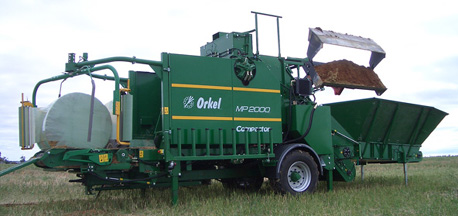
Removal of Silage:
After a period of 40-45 days the silage is ready for feeding to the
livestock. After the removal of silage the open end of the silo should be covered in such a manner that contact with the
air is minimum.

Process of Ensiling
The whole process may be divided into four different phases.
Although initial two phases have no any clear cut marking. In most
of the cases these are merged together, however, for easy
understanding they have been described separately:
Phase I – The phase I immediately starts after sealing the tightly
filled silo. The plant cells continue to respire till the oxygen
trapped is exhausted. The carbon dioxide production makes the silo
anaerobic. This favors the growth of anaerobic bacteria.
Phase Il - At the initial stage clostridia and coliform bacteria are
active, causing degradation of protein and amino acid and production
of amine and acetic acid. Lactic acid producing bacteria are also
increased.
Phase III - The lactic acid producing bacteria dominate and
cause increase in lactic acid production and
reduction in pH of ensiled material. The presence of readily available
carbohydrate enhanced the growth of such types of desired bacteria
producing lactic acid and reducing the pH.
Phase lV - This phase is quite variable and dependent on phase III.
If pH is reduced to around 4 silage is stable and no further
degradation occurs. If sufficient acid is not produced to bring down
the pH round 4 microbial activities still continues. High
moisture contents favours this undesirable fermentation.
Advantages of Silage Making
-
Surplus
green fodder abundantly available can be preserved as silage for
feeding during lean season
-
The organic
acids produced in the silage are similar to those normally produced
in the digestive tract of the ruminants; so digestibility of fodder increases
-
It eliminates
wastage of the less favoured parts of the fresh fodder like stem
because the animals consume entire plant.
-
It is
highly palatable
-
It cannot be
destroyed by fire
-
It provides
succulent feed particularly during dry periods, when the
vegetation growth is dormant.
-
It is more
economical as compared to cut-and-carry prevailing system.
Quality of Silage
Good silage should have a milk, pleasant aroma, an acid taste and a
slightly greenish color. It should be free from sliminess and mold
and have sufficient acid to prevent further action of
microorganisms.
Causes of Poor Silage:
These are different factors which may lower the quality of silage:
Acid Production:
If
during silage making acid is not produced in sufficient quantity, it will
stop the fermentation, and there will be putrefaction due to
undesirable bacteria. Such bacteria will produce enzymes that will
cause the breakdown of protein causing an off flavor and slimy
silage. On the other hand if there is production of acid in high
quantity due to high proportion of sugar content, it will result in
sour unpalatable silage. Such silage is not only unpalatable, but
when fed in large quantity causes cattle to scour.
Moisture Content:
When there is high moisture content in fodder, the silage will not
be
packed well and more air will be left in it. This will result in moldy
silage. High moisture content causes undesirable fermentation to take place.
In case of less moisture content there will be no proper
fermentation.
|

![]()


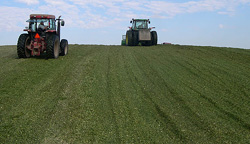
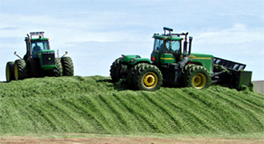
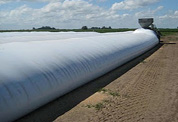
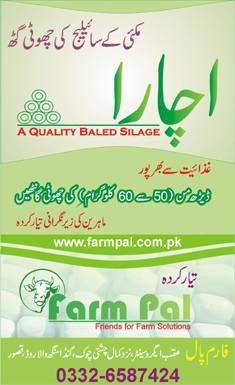





















 e
e








